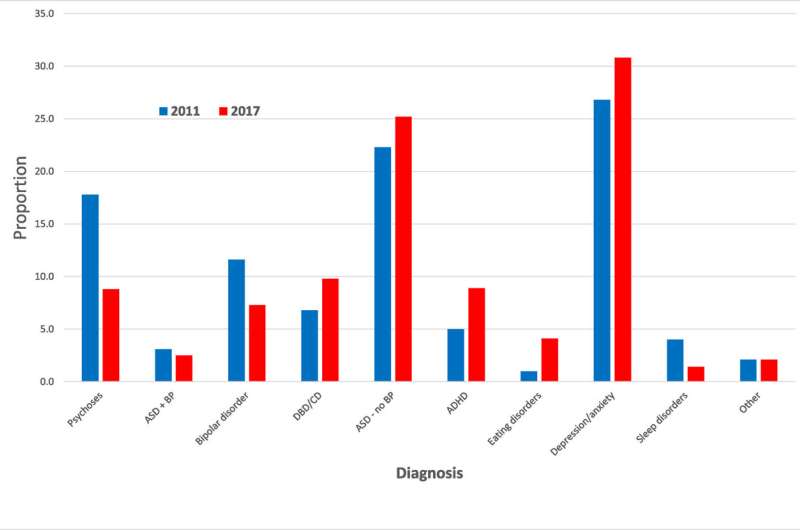This article has been reviewed according to Science X's editorial process and policies. Editors have highlighted the following attributes while ensuring the content's credibility:
fact-checked
trusted source
proofread
Australian study finds risky increase in antipsychotic drugs for children

Australian GPs are prescribing more antipsychotic drugs to children and adolescents for non-approved conditions, according to a new study by University of Adelaide researchers.
The study, which has been published in JCPP Advances, investigated antipsychotic prescribing patterns to children and adolescents diagnosed with mental health conditions in 2011 and 2017, using a large general practice database, MedicineInsight.
It found high levels of off-label prescribing, which is the prescribing of drugs for unapproved medical conditions. In Australia, the Therapeutic Goods Administration (TGA) has approved pediatric antipsychotics only for bipolar disorder, psychoses, and severe self-destructive, disruptive, or aggressive behaviors.
The researchers found that children and adolescents were more likely to be prescribed antipsychotics in 2017 than in 2011, and off-label prescribing was 10% higher in 2017, reaching almost 80% of all patients prescribed antipsychotics. In both years, the main reason for prescribing antipsychotics was depression or anxiety—both off-label uses.
"These findings are particularly concerning because of the potential harms for children and adolescents," said University of Adelaide Professor Jon Jureidini, Research Leader of the Robinson Research Institute's Critical and Ethical Mental Health group.
"There are well-known cardiometabolic adverse effects associated with antipsychotics, and studies have shown that pediatric patients develop these symptoms much more rapidly than adults taking these drugs. That puts children at increased risk for the development of metabolic syndrome and diabetes in childhood, and chronic cardiovascular diseases in adulthood."
The study also examined the sociodemographic characteristics of patients prescribed off-label antipsychotics. Off-label prescribing increased most in older adolescents aged 15–18 years, patients in regional and remote areas and patients in the most disadvantaged areas.
It found 70 percent of children and adolescents were prescribed another psychiatric drug at the same time as the antipsychotic, in both years studied. The concurrent use of psychiatric drugs increases the risk of adverse events and should only rarely occur in pediatric patients.
"Despite the risks, off-label prescribing is still common in children and adolescents because there are so few studies performed in this population, so evidence on effectiveness and safety is limited, and consequently, approvals by the TGA are few and far between," said lead author Julie Klau, a Ph.D. candidate in the Critical and Ethical Mental Health research group.
"GPs are legally allowed to prescribe off-label but must take extra precautions because of the lack of good evidence. The increase in off-label prescriptions of antipsychotics among vulnerable children is of concern and requires further action."
According to the authors of the study, there is an urgent need to investigate why such high levels of off-label antipsychotic prescribing are occurring, especially among disadvantaged children, and why there are so many children taking multiple psychiatric drugs.
More information: Julie Klau et al, Antipsychotic prescribing patterns in children and adolescents attending Australian general practice in 2011 and 2017, JCPP Advances (2023). DOI: 10.1002/jcv2.12208



















